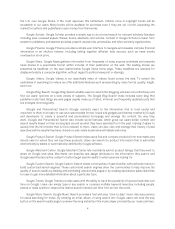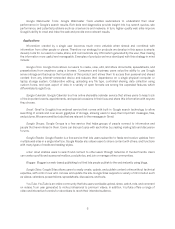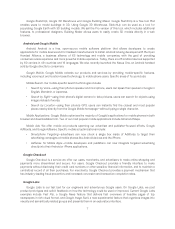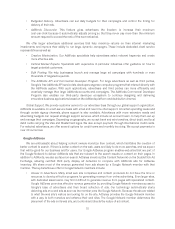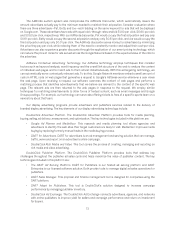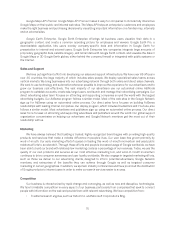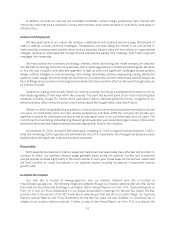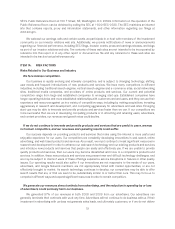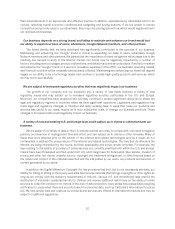Google 2009 Annual Report Download - page 30
Download and view the complete annual report
Please find page 30 of the 2009 Google annual report below. You can navigate through the pages in the report by either clicking on the pages listed below, or by using the keyword search tool below to find specific information within the annual report.Google AdSense for Mobile Applications. For developers creating applications for high-end mobile phones,
such as the iPhone or Android-based phones, AdSense for Mobile Applications allows them to generate revenue by
showing relevant advertising in their applications.
Google AdSense for Video. For web sites with video content, AdSense for Video allows the web site to
generate revenue from their video content by inserting relevant AdWords text and video ads within their videos.
Google AdSense for Feeds. AdSense for Feeds is a free program that allows publishers to monetize their
feeds through text ads targeted to the content of the feed. Feeds are content streams that users subscribe to that
contain structured data such as stock and financial information, web blog posts, and weather reports.
Google AdSense for Games. AdSense for Games allows web-based game developers to generate revenue by
inserting relevant advertising within their games.
Google Television Ads. Google Television Ads is a product that allows advertisers to use their AdWords
account to create television campaigns. Advertisers can use our online advertising platform to place and monitor
the effectiveness of their television ads, enhancing relevance and accountability.
Display Advertising
Display advertising comprises the videos, images, banners, Adobe Flash, and other interactive ads that run
across the web. Today Google serves display ads across the Google Network. We also offer a variety of display ads
such as videos, images, and Flash ads on YouTube. Our goal across both the Google Network and YouTube is to
deliver the best possible performance for advertisers.
With our acquisition of DoubleClick, we also provide ad serving technology to publishers, agencies, and
advertisers, which is the infrastructure that enables billions of ads to be served each day across the web. Buying
and selling display advertising is still a very complicated process, and we plan to simplify that process through the
evolution of these platforms.
Finally, we recently launched the DoubleClick Ad Exchange to create an open marketplace for the trading
of display ad space. This will open up the display ecosystem for participants of all sizes.
The Technology Behind Google’s Advertising Programs
Our AdWords and AdSense programs serve millions of relevant, targeted ads each day based on search terms
users enter or content they view on the web. The key elements of our advertising technology include:
Google AdWords Auction System. The Google AdWords auction system lets advertisers automatically deliver
relevant, targeted advertising. Every search query we process involves the automated execution of an auction,
resulting in our advertising system often processing hundreds of millions of auctions per day. To determine
whether an ad is relevant to a particular query, this system weighs an advertiser’s willingness to pay for
prominence in the ad listings (the cost-per-click or cost-per-impression bid) and interest from users in the ad as
measured by the click-through rate and other factors. Our Quality-based bidding system also assigns first page
bids to advertiser keywords based on the Quality scores of those keywords—the higher the Quality score, the lower
the first page bid. The Quality score is determined by an advertiser’s keyword click-through rate, the relevance of
the ad text, historical keyword performance, the quality of the ad’s landing page and other relevancy factors. This
prevents advertisers with irrelevant ads from “squatting” in top positions to gain exposure, and rewards more
relevant, well-targeted ads that are clicked on frequently. Because we are paid only when users click on ads, the
AdWords ranking system aligns our interests with those of our advertisers and our users. The more relevant and
useful the ad, the better for our users, for our advertisers and for us.
12




